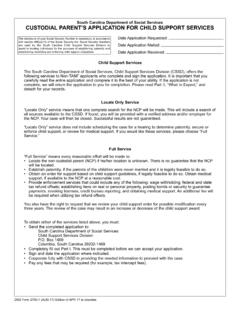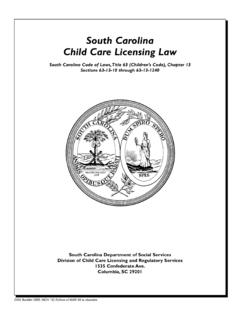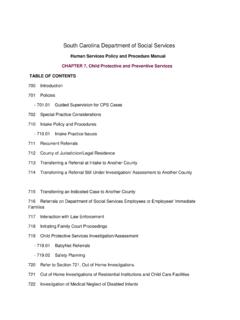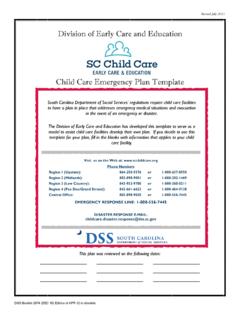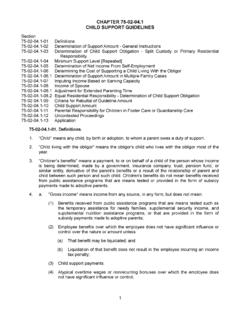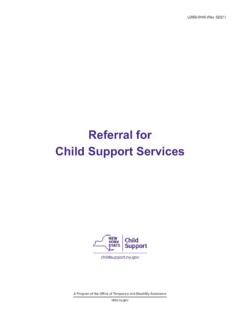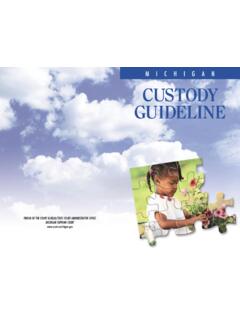Transcription of 2014 Child Support Guidelines Booklet - South Carolina
1 South Carolina Child Support Guidelines 2014 EDITION Table of Contents 1. Introduction .. 1 2. Use Of The Guidelines .. 1 3. determination of Child Support Awards .. 3 A. Income .. 3 1. Definition .. 3 2. Gross Income .. 3 3. Gross income does not include:.. 4 4. Income from Self Employment or Operation of a Business .. 4 5. Potential Income .. 4 6. Income Verification .. 5 7. Monthly Alimony (this action) .. 5 8. Other Monthly Alimony or Child Support Paid .. 6 9. Other Children in the Home .. 6 10. Basic Child Support Obligation .. 6 11. Self Support Reserve .. 6 12. Health Insurance .. 7 13. Child Care Costs .. 7 14. Computation of Child Support .. 8 4. Unusual Custody Arrangements .. 9 A. Shared Parenting Arrangements .. 9 B. Split Custody .. 10 5. Periodic Review .. 11 6. Child Support Guidelines Schedule and Worksheets .. 11 7. Fiscal Impact Statement .. 11 8. Statement of Rationale .. 11 1 | Page 1. INTRODUCTION The South Carolina General Assembly, through Act 195 of 1989, provides that the Child Support Guidelines must be applied by the courts in determining the amount of Child Support that is expected to be paid toward the Support of a dependent Child (Section 43 5 580(b) and 20 7 852(a), South Carolina Code of Laws, 1976 as Amended).
2 These Guidelines are based on the Income Shares Model, developed by the Child Support Guidelines Project of the National Center for State Courts. Developed with the best available economic evidence on Child rearing expenditures, the Income Shares Model is based on the concept that the children should receive the same proportion of parental income that they would have received had the parents lived together. A more detailed explanation of the Income Shares Model and the underlying economic evidence used to Support it is contained in Development of Guidelines for Child Support Orders, Report to the Federal office of Child Support Enforcement, September 1987 (National Center for State Courts, Denver, Colorado). The Income Shares Model calculates Child Support as the share of each parent s income which would have been spent on the children if the parents and children were living in the same household. The shares are based on the amount of money ordinarily spent on children by their families living in the United States and adjusted to South Carolina cost of living levels.
3 This evidence indicates that individuals tend to spend money on their children in proportion to their income, and not solely on need. The expenditures include the following nine categories: food at home; food away from home; shelter; utilities; household goods (furniture, appliances, linens, floor coverings, and house wares); clothing; transportation (other than visitation related); ordinary health care; and recreation. Excluded from these expenditure categories are estimated expenditures for Child care and Child Support on an as paid basis. Also excluded from these estimates are personal insurance ( life, disability), gifts, contributions, and savings. Because mortgage principal (as opposed to interest) is considered to be savings, it is not included in the estimates of Child rearing expenditures. These Guidelines and the accompanying worksheets assume that the parent to whom Support is owed is spending his or her calculated share directly on the Child . For the parent with the obligation to pay Support , the calculated amount establishes the level of Child Support to be given to the custodian for Support of the Child .
4 2. USE OF THE Guidelines A. The Child Support Guidelines are available to be used for temporary and permanent orders, actions for separate maintenance and Support , divorce and Child Support awards. Additionally, the Guidelines are to be used to assess the adequacy of agreements for Support and encourage settlement of this issue between parties. 1. In any proceeding in which Child Support is an issue, the amount of the award which would result from the application of these Guidelines is the amount of the Child 2 | Page Support to be awarded. However, a different amount may be awarded upon a showing that application of the Guidelines is inappropriate. When the court orders a Child Support award that varies significantly from the amount resulting from the application of the Guidelines , the court shall make specific, written findings of those facts upon which it bases its conclusion supporting that award. 2. In cases where the parents combined monthly gross income is less than $ , the Guidelines provide for a case by case determination of Child Support , which should ordinarily be set at no less than $ per month.
5 In those cases, the court should take care to award an amount of Child Support that would not jeopardize the ability of the parent with the legal obligation to pay Support to live at a minimum level of subsistence. However, the Guidelines encourage that a specific amount of Child Support always be ordered to establish in the payer s mind the principle of the parent s obligation to pay as well as lay the basis for increased/decreased orders if income changes in the future. 3. These Guidelines provide for calculated amounts of Child Support for a combined parental gross income of up to $30,000 per month, or $360,000 per year. Where the combined gross income is higher, courts should determine Child Support awards on a case by case basis. B. Deviation from the Guidelines should be the exception rather than the rule. When the court deviates, it must make written findings that clearly state the nature and extent of the variation from the Guidelines . These Child Support Guidelines do not take into account the economic impact of the following factors which can be possible reasons for deviation.
6 1. Educational expenses for the Child (ren) or the spouse ( , those incurred for private, parochial, or trade schools, other secondary schools, or post secondary education where there is tuition or related costs); 2. Equitable distribution of property; 3. Consumer debts; 4. Families with more than six children; 5. Unreimbursed extraordinary medical/dental expenses for either parent, or extraordinary travel expenses for court ordered visitation; 6. Mandatory deduction of retirement pensions and union fees; 7. Child related unreimbursed extraordinary medical expenses; 8. Monthly fixed payments imposed by court or operation of law; 9. Significant available income of the Child (ren); 3 | Page 10. Substantial disparity of the parents incomes; 11. Alimony. Because of their unique nature, lump sum, rehabilitative and reimbursement alimony may be considered by the court as a possible reason for deviation from these Guidelines ; 12. Agreements Reached Between Parties. The court may deviate from the Guidelines based on an agreement between the parties if both parties are represented by counsel or if, upon a thorough examination of any party not represented by counsel, the court determines the party fully understands the agreement as to Child Support .
7 The court still has the discretion and the independent duty to determine if the amount is reasonable and in the best interest of the Child (ren). 3. determination OF Child Support AWARDS A. INCOME 1. DEFINITION The Guidelines define income as the actual gross income of the parent, if employed to full capacity, or potential income if unemployed or underemployed. Gross income is used in order to avoid contention over issues of deductibility which would otherwise arise if net income were used. The Guidelines are based on the assumption that the parent with the legal obligation to pay Support will have only one federal exemption and will have higher taxes than the parent to whom Support is owed. Adjustments have been made in the Schedule of Basic Child Support Obligation for lower Child Support payments. Other factors included in the schedule are South Carolina taxes, FICA, and earned income. 2. GROSS INCOME Gross income includes income from any source including salaries, wages, commissions, royalties, bonuses, rents (less allowable business expenses), dividends, severance pay, pensions, interest, trust income, annuities, capital gains, Social Security benefits (but not Supplemental Social Security Income), workers compensation benefits, unemployment insurance benefits, Veterans benefits and alimony, including alimony received as a result of another marriage and alimony which a party receives as a result of the current litigation.
8 Unreported case income should also be included if it can be identified. A. The court may also take into account assets available to generate income for Child Support . For example, the court may determine the reasonable earning potential of any asset at its market value and assess against it the current treasury bill interest rate or some other similar appropriate method of computing income. B. In addition to determining potential earnings, the court should impute income to any non income producing assets of either parent, if significant, other than a 4 | Page primary residence or personal property. Examples of such assets are vacation homes (if not maintained as rental property) and idle land. The current rate determined by the court is the rate at which income should be imputed to such nonperforming assets. 3. GROSS INCOME DOES NOT INCLUDE: A. Benefits received from means tested public assistance programs, such as Temporary Assistance to Needy Families (TANF), Supplemental Security Income (SSI), Food Stamps and General Assistance; B.
9 Income derived by other household members; and/or C. In kind income; however, the court should count as income expense reimbursements or in kind payments received by a parent from self employment or operation of a business if they are significant and reduce personal living expenses, such as a company car, free housing, or reimbursed meals. With regard to military allotments, individuals not receiving Housing allotments should be imputed with the BAH II amount for dependents. This differential is consistent and unrelated to the domicile location of the service member, as well as easily obtained. 4. INCOME FROM SELF EMPLOYMENT OR OPERATION OF A BUSINESS For income from self employment, proprietorship of a business, or ownership or a partnership or closely held corporation, gross income is defined as gross receipts minus ordinary and necessary expenses required for self employment or business operation, including employer s share of FICA. However, the court should exclude from those expenses amounts allowed by the Internal Revenue Service for accelerated depreciation of investment tax credits for purposes of the Guidelines and add those amounts back in to determine gross income.
10 In general, the court should carefully review income and expenses from self employment or operation of a business to determine actual levels of gross income available to the parent to satisfy a Child Support obligation. As may be apparent, this amount may differ from the determination of business income for tax purposes. 5. POTENTIAL INCOME If the court finds that a parent is voluntarily unemployed or underemployed, it should calculate Child Support based on a determination of potential income which would otherwise ordinarily be available to the parent. If income is imputed to a parent to whom Support is owed, the court may also impute reasonable day care expenses. Although Temporary Assistance to Needy Families (TANF) and other means tested public assistance benefits are not included in gross income, income may be imputed to these recipients. However, the court may take into account the presence of young children or handicapped children who must be cared for by the parent, necessitating the parent s inability to work.
